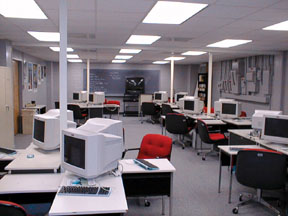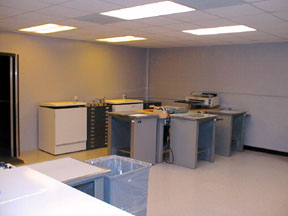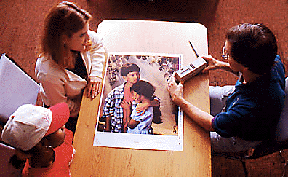

In 1998, Dr. Bernard McIntyre, Dean of the College of Technology, commissioned a five-year strategic plan for the Graphic Communications Technology (GCT). The plan was completed by a committee composed of a cross-section of Texas Printing Education Foundation (TPEF) board members, GCT alumni, representatives from the Printing Industries of the Gulf Coast, and the GCT curriculum coordinator (Dr. Jerry Waite). The plan contained a thorough evaluation of the existing program and suggestions to make the program stronger . Two major recommendations were given: (1) to revise the course structure to make it even stronger, and (2) to expand the facilities to house an ever-growing student population.
Based upon the strategic plan, Dr. McIntyre allocated nearly 4,000 additional square feet of laboratory space in the 102 Wing of Building T to be used for GCT courses. The space allocated by the Dean is in an historically significant building known on campus as Technology I (Building T). Technology I was one of the original University of Houston buildings and was constructed in the late 1920's. During the 1940's, the building gained some notoriety because it was used by the military as the Houston-area training facility for personnel preparing to fight in World War II. It is reportedly one of the first air-conditioned classroom buildings built in the State of Texas.
 |
Of the approximately 4,000 square feet allocated by the Dean to GCT, 1,500 square feet (known as Rooms 102A-T and 102B-T) was occupied in Fall 1999. Digital prepress, multimedia, and web development classes are taught in Room 102A-T (see photo above at left). Room 102A-T accommodates 20 students and Macintosh G3 or G4 workstations as well as output devices and other peripherals. |
| Conventional prepress is taught in Room 102B-T (see photo at right). Room 102B-T is used as a service room as necessary (no stand-alone traditional prepress courses are offered in the GCT curriculum). Students learn basic process photography, film assembly, imposition, proofing, and platemaking during the Image Technology I course. |  |
| The remaining 2,500 square feet, known as Room 102F, will be used for image transfer--single and multicolor conventional and digital press equipment. About half of the laboratory is currently filled with offset-lithographic presses. The remaining portion has been set aside for digital printing devices, screen printing equipment, and, perhaps, a flexographic press. |
During summer 1999, several grants were received to upgrade and augment GCT's existing equipment. In particular, a $15,000 grant was made by the Texas Printing Education Foundation (TPEF), $10,000 was received from the Nolan Moore Foundation, and $2,500 was given by Clampitt Paper Company. These grants were augmented by $25,000 in matching funds made available by the UH College of Technology.
The grants from the TPEF and the Nolan Moore Foundation were presented to Dean McIntyre on May 27, 1999 by Jim White, TPEF Chairman, Ken Piercy, Executive Director of Printing Industries of the Gulf Coast, and Joe Polanco, Executive Director of the Nolan Moore Foundation. Pictured are, from left to right, Dr. Jerry Waite, GCT program coordinator, Dean Bernard McIntyre, Jim White, Ken Piercy, and Joe Polanco.
The $52,500 were used to purchase new prepress equipment and to upgrade existing equipment. The completed Digital Prepress Laboratory houses the following equipment: 20 Power Macintosh G3 and G4 work stations, an Agfa imagesetter/platesetter with a dedicated Power Macintosh RIP station, a Power Macintosh G3 file server, a big-screen television monitor for classroom demonstrations, an Imation Rainbow color proofer, an Agfa desktop scanner, an 800 dpi tabloid-sized laser printer, a 3M plate processor, two OVAC exposure units, a Stoesser pin-registration system, an Argyle process camera, and a variety of light- and work-tables. The Macintosh workstations are equipped with QuarkXPress, Adobe Photoshop, Adobe Illustrator, Adobe PageMill, Macromedia Director, Adobe Streamline, Adobe Premiere, Adobe PageMaker, Markzware Flightcheck, DK&A InPosition, X-Rite ColorShop, Microsoft Internet Explorer, and PANTONE Hexwrench. The Digital Prepress Technology laboratory is open only for students enrolled in UH graphic communications technology courses or students taking non-credit courses offered by the Texas Printing Institute.
 All UH graphic
communications technology courses stress quality control equipment
and processes. Students in the photograph are shown using an extremely
important quality-control tool, the reflection densitometer. Students
in the UH program also use such sophisticated tools as the colorimeter
and reflection spectrophotometer.
All UH graphic
communications technology courses stress quality control equipment
and processes. Students in the photograph are shown using an extremely
important quality-control tool, the reflection densitometer. Students
in the UH program also use such sophisticated tools as the colorimeter
and reflection spectrophotometer.
The College of Technology is very grateful to the following firms and organizations for providing equipment and/or funds used to outfit the graphic communications technology laboratories: the Texas Printing Education Foundation, the Houston Litho Club, the Nolan Moore Foundation, 3M Company (Imation), Olec Corporation, College of the Mainland, GTI Technologies, Printing Industries of the Gulf Coast, Agfa, Phillips & Jacobs, Varn, Gans Ink, Unisource Paper, Clampitt Paper, Kwik Kopy Corporation, the University of Houston Printing Plant, C & H Rigging, and Wood Electric.